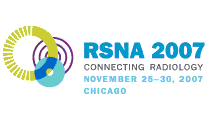
Abstract Archives of the RSNA, 2007
Thorsten Alexander Bley MD, Presenter: Nothing to Disclose
Lagreze Wolf, Abstract Co-Author: Nothing to Disclose
Gaggel Miriam, Abstract Co-Author: Nothing to Disclose
Robin Munk, Abstract Co-Author: Nothing to Disclose
Weigel Mathias PhD, Abstract Co-Author: Nothing to Disclose
Mathias F.J. Langer MD, PhD, Abstract Co-Author: Nothing to Disclose
With age and under certain pathologic conditions, such as intracranial hypertension, glaucoma or papilledema, the diameter of the ON and its CSF sheath may change. The purpose of this study was to compare a very fast half Fourier-acquired single shot turbo spin echo (HASTE)-sequences at 3T MRI with conventional sonography of the retrobulbar optic nerve to analyze optic nerve dimensions.
33 halthy underwent 3T MRI of the right eye. HASTE sequences were aquired in straight gaze perpendicular to the optic nerve within 5 mm, 10 mm and 15 mm behind the eye (TR/TE 1500/146 ms, TA 1.5 sec., number of excitations 1, bandwidth 195 Hz/pixel, FOV 23 x 18 cm2, Matrix 512 x 367, nominal spatial resolution 0.45 x 0.49 mm2, interpolated to a higher matrix size of 2048 x 1468 with a pixel size of 0.11 x 0.12 mm2, slice thickness 3 mm). A-scan ultrasonography and B-scan ultrasonography were repeated three times in straight gaze. 95% confidence intervals and coefficients of variation were calculated.
Acquisition time for the HASTE sequence was 1.5 seconds per slice. Optic nerve diameters decreased from 3.23 mm at 5 mm to 2.67 mm at 15 mm behind the eye. The sheath diameters decreased from 5.72 mm to 3.98 mm. The coefficients of variation ranged between 4% anteriorly and 7% posteriorly. For the sheath they varied between 3% and 7%, respectively. Compared to the MRI readings, ultrasonographic measurements consistently yielded smaller diameters. In the A-scan mode, the diameter of the retrobulbar optic nerve was 2.31 mm, and 4.08 mm of the sheath. The coefficients of variation were 9% and 13%, respectively. Slightly higher diameters of the optic nerve and its sheath were obtained in the B-scan mode.
3T MRI depicts the optic nerve and its sheath within the full intraorbital track with high contrast. HASTE-sequences appear particularly appropriate to investigate the retrobulbar optic nerve complex and may be useful for quantifying axonal loss within the optic nerve and for assessment of differential diagnoses in optic nerve disease.
Precise quantification of axonal loss of the optic nerve may be of interest in assessment of severity of glaucoma and can be achieved with MRI.
Bley, T,
Wolf, L,
Miriam, G,
Munk, R,
Mathias, W,
Langer, M,
Morphometry of the Retrobulbar Human Optic Nerve: Comparison of 3T MRI with Conventional Sonography. Radiological Society of North America 2007 Scientific Assembly and Annual Meeting, November 25 - November 30, 2007 ,Chicago IL.
http://archive.rsna.org/2007/5013450.html

